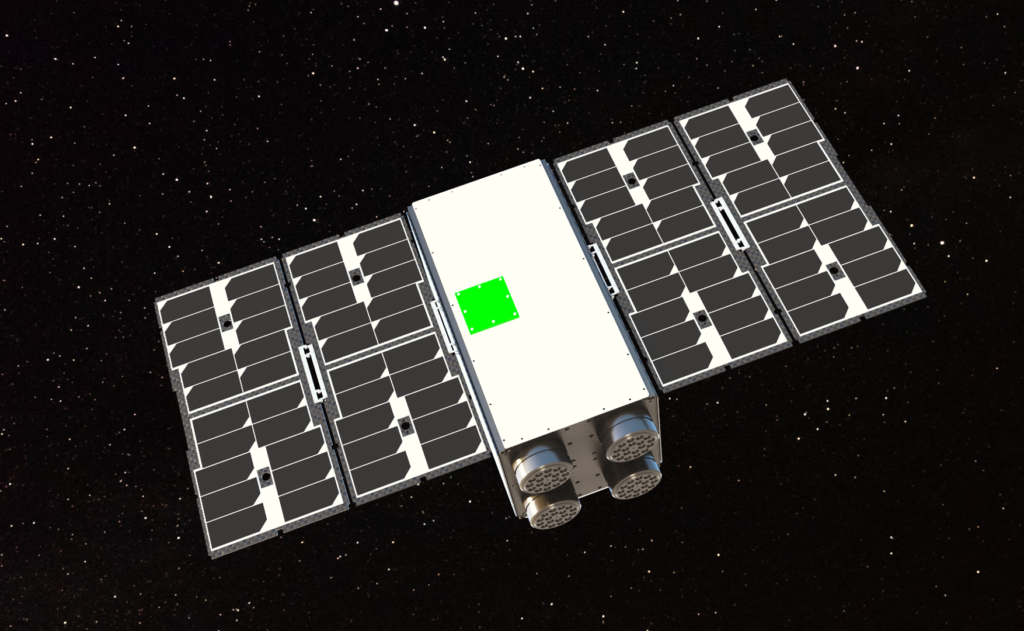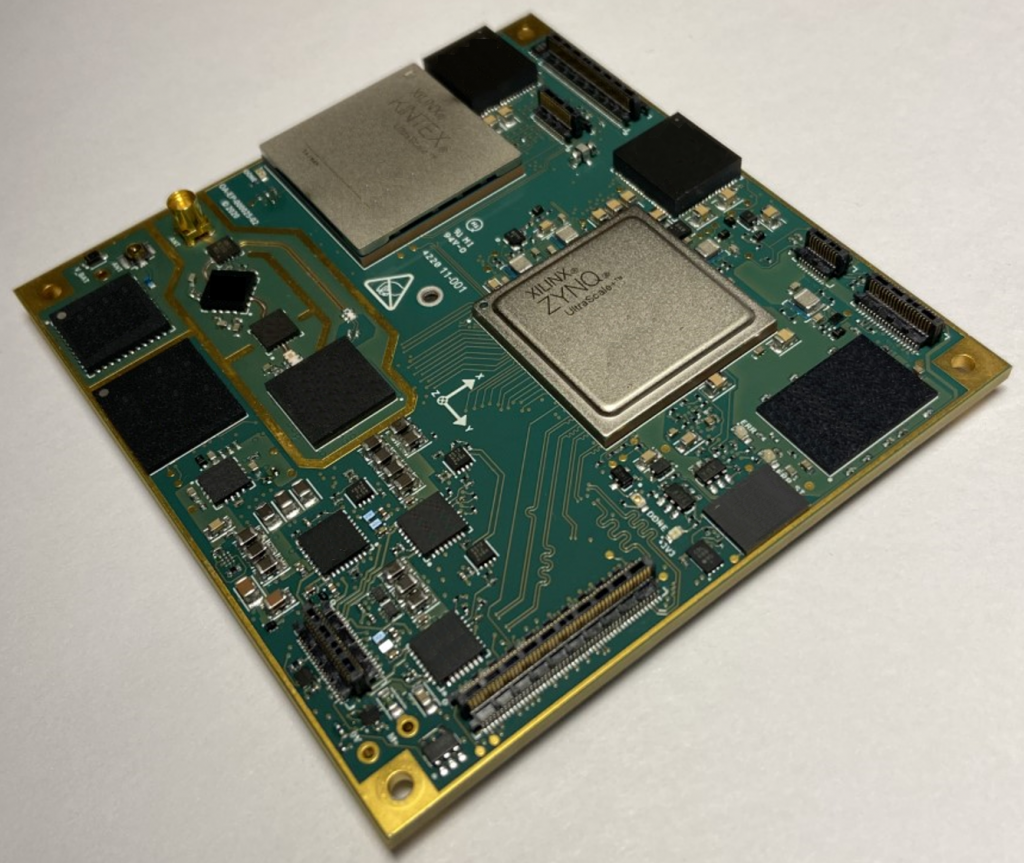
OrbAstro has made available the world’s most capable 16U satellite platform, that is delivered on a lead-time and at a price-point that is simply unmatched.
£250,250
+£13,000/kg (TBC) for launch
Included in this price: the satellite platform, engineering support with payload integration, flight-acceptance testing of the fully integrated satellite, and storage before shipment to the launch provider. Launch can be managed by OrbAstro and provided through a 3rd-party partner; price displayed is indicative of standard LEO/SSO orbit. Spectrum filing and launch license can be managed on a case-by-case basis.
This product-line has been made possible through contracts with:

|
Spec |
Baseline Option |
Upgrade Options |
|
OBC |
Telos-40 |
Additional Telos-10, Telos-40, and Telos-45 |
|
EPS |
72Wh |
144Wh, 280Wh, 560Wh |
|
Comms |
S-band transceiver + antenna (5Mbps), optical transceiver ( Guardian Network ) |
Additional X-band transmitter with 22dBi reflect-array antenna, Ka-band transmitter with 33dBi reflect-array antenna |
|
ADCS |
0.1º pointing accuracy, 0.01º knowledge, dual star-trackers |
— |
|
Electric Propulsion |
Max thrust 232μN, delta-V typically 0.46km/s |
— |
|
Solar Panels |
Chassis mounted, 20W |
Deployable panels, up to 136W |
|
Redundancy |
— |
OBC, EPS, ADCS, RF |
|
Lifetime |
8-10 years |
— |
|
Spec |
Description |
|
Volume |
~ 16.5U maximum (296x220x100mm + 420x220x110mm) |
|
Mass |
Up to 19kg (baselining a 30kg satellite maxi mass) |
|
Power |
Maximum power consumption dependent on battery configuration; 400W for 72Wh/144Wh, 1.4kW for 280Wh, and 2.8kW for 560Wh. |
|
Data Interfaces |
I2C: 2x interfaces @10, 100, 400, 1000 kHz SPI: 1x interfaces @1, 10, 40 MHz USART: 2x interfaces, up to 1 Mb/s CAN: 2x interfaces, up to 1 Mb/s LVDS: 10 pairs, up to 1.2 Gbps per pair PCIe 3.0, up to x4 USB 2.0 Ethernet 10/100/1000Mbps |
-
- You place a 2% deposit per satellite to secure yourself in the production queue and at the “early adopter rate”.
- You hire a flat-sat to design/program your payload for compatibility with the platform.
- Once ready, you pull the trigger for platform build.
- Once the platform is built (nominally 1 month later), you come on-site and integrate your payload with assistance from our engineers. This should not take more than a few days because of your upfront work on the flat-sat .
- Whilst you are on-site, we put the fully integrated satellite through fight-acceptance testing. This should not take more than few days after your payload has been integrated.
- After passing flight-acceptance testing and further health-checks, the satellite is securely stored on-site in an appropriate environment until the launch provider is ready to receive it.
- You organise shipment of the satellite from OrbAstro to your designated launch provider, we support with export paperwork.
£250,250 baseline
The price includes:
-
- A fully assembled 16U satellite platform
- Engineering support with payload integration, on-site with us
- Full flight-acceptance testing and associated health-checks, on-site with us
- Packaging for transportation
- Storage of the satellite until the launch provider is ready to receive it
Nominal lead-time for production of satellite platforms is 1 month. Depending on optional extras and if there are chassis delta-designs, this can increase to 2-3 months.
Deposits are 2% of baseline price of satellite.
|
Upgrade/Additions |
Description |
|
Launch +£13,000/kg (TBC) |
OrbAstro management of launch through a 3rd-party partner. Price dependent on launch provider and orbit selected. Includes launch, ejector ring, and management. |
|
Spectrum Filing & Launch License +£41,800 (TBC) |
OrbAstro can manage the acquisition or relevant paperwork associated with launching and operating the satellite. Price is dependent on on unique customer requirements. |
|
Dual-Redundancy +£69,500 |
Duplicate OBC, EPS electronics, ADCS, and S-band RF to increase reliability, robustness, and mission lifetime. Will reduce payload volume by ~0.6U. |
|
OBCs |
Additional OrbAstro Telos-class OBCs can be add to the platform for various applications. Each additional OBC will reduce payload volume by ~0.1U. |
|
Battery 144Wh, +£10,100 |
To increase power storage capacity of the platform, the battery can by upgraded. This will reduce payload volume capacity by ~0.7U for 144Wh, ~2U for 280Wh, and ~4.5U for 560Wh variants. |
|
Deployable Solar Panels 1-wing-1-panel (+20W), +£18,000 |
Power available to the payload can be increased in increments with the addition of deployable solar panels. This will not impact payload volume capacity. |
|
High-Speed Downlink X-band transmitter with 22dBi antenna, +£48,300 Ka-band transmitter with 38dB antenna, +£60,700 |
To increase down-link capabilities, an OrbAstro Ka-band transmitter can be added with a reflect-array antenna. This will compliment the S-band transceiver. |
|
Deployable TT&C +£12,600 |
Mount S-band Tx/Rx antennas on panel that deploys 90/180deg from chassis to enable more flexibility on satellite-payload configuration. |
|
Additional Onboard Storage 128GB, +£3,300 |
Increasing capacity of onboard storage extends what is achievable and flexibility of a mission. |
|
Electrical Interfaces First two electrical interfaces included in baseline price, additional interfaces incur +£2,750 per interface. |
I/F Options: |
|
High-Speed Electrical Interfaces Each interfaces incurs +£2,750 Requires at least a Telos-10 OBC to compliment. |
I/F Options: |
|
Chassis Modifications Minor cut-outs and modifications (and delta-analysis), +£19,000 |
Sometimes a payload will not be compatible with our baseline chassis. Sometimes, instead of modifying the payload to conform, it makes more sense to modify the chassis. |
|
SpaceWire +£15,200 |
Spacecraft communication network based in part on the IEEE 1355 standard of communications. |
|
Boot ROM ECC +£2,500 |
OrbAstro-managed over-the-air updates with hardware-level ECC for boot ROM. |
|
CSP +£7,000 |
Baseline CSP including 2 interfaces. Each additional interfaces +£1,250. Requires at least a Telos-10 OBC to compliment. |
|
OrbAstro-managed Interfaces +£2,500 |
OrbAstro takes care of payload interfaces, data is pushed and pulled from DRAM. |
|
Payload Access No cost implication with choice. |
CFRP panels mounted to the chassis around the payload can either be left in place (closed) or removed (open). Removing of some or all of these panels allows for surface access and customisation. |
|
Warranty +15% of total satellite price |
Replacement of satellite platform and associated service within this contract if there is a Constructive Total Loss of the mission between satellite departure from OrbAstro premises and the completion of one year of in-orbit operations (terrestrial transportation, in-orbit commissioning, and one year of in-orbit operations). Note this does not include warranty against launch failure or failure of Customer payload. |
All subsystems have been subjected to extensive testing, are flight qualified, and have flight heritage. The same subsystems are used across the entire ORB-class satellite platform range.
Subsystems

The volumetric efficiency of the ORB family of satellite platforms has been enabled by the team compressing what is typically seven 1U-scale PCBs into a single 80x75mm board. This “satellite on a board” contains: the OBC, reaction wheel controls, magnetorquer controls, camera interfaces, star-tracker interfaces, all sensor interfaces, full SDR S-/X-band, GPS, optical data processing and control, and EPS.
-
- The platform utilises an OrbAstro Telos-40 OBC.
- The OBC is based on Xilinx Ultrascale+ MPSoCs with ARM cortex A53 and R5 64-bit processing cores, 2GB LPDDR4, 64GB eMMC, 250GFLOP double precision FPU, software and hardware based mitigation for SEU and SEL.
- Additional customer-dedicated onboard computers can be provided for various applications.
-
- The platform hosts an optical communications system for data relay through the Guardian Network satellites. Subscription packages vary, but 500MB/day uplink/downlink with up to 24 links per day is the baseline. Service available from mid-2024.
- As a back-up, and until the Guardian Network satellites become operational, the platform contains an S-band transceiver and antenna with a 5Mbps typical data rate at 1,000km for conventional ground link. All Guardian Network ground stations are capable of supporting S-band, X-band, and Ka-band links. Three associated ground stations will be operational over the course of 2022.
- The S-band transceiver can be complimented with a Ka-band transmitter and antenna. The transmitter typically provides an additional 2Gbps downlink at 2,000km range.
-
- The ADCS is based on an array of reaction wheels, magnetorquers, dual star-tracker cameras, Earth and Sun cameras, magnetometers, gyroscopes, and GPS unit, with a relatively comprehensive level of redundancy built in.
- It provides highly accurate pointing control authority (<0.1deg/s) and pointing knowledge (<0.01deg/s) in both Solar and Eclipse phases.
- High precision dual star-trackers heads for redundancy.
- Dual redundant 3-axis magnetorquers.
- It provides extremely high torque authority (40mNm) and momentum storage capacity (38mNms), typically an order of magnitude higher than what is conventionally available for 6U satellites. This ability for agile steering/pointing enables the customer to increase the amount of useful data collected by their payload (i.e. by jumping between points of interest through the orbit rather than say maintaining a fixed NADIR-pointing angle). The overhead for this type of target-tracking operation is much compressed when coupled to the Guardian Network autonomous mission operations service.
-
- A quad electric propulsion system is contained within the “tuna cans” of the platform. It provides a maximum thrust of 464μN and a delta-V of 0.35km/s (baselining a 10kg spacecraft).
- The unit enables accelerated deployment, accelerated RAAN drift, formation maintenance, station-keeping, collision avoidance, and active deorbit capabilities.
- The design is highly robust and reliable with independent thruster heads, multiple neutralisers, redundancy built into the integrated electronics, no pressurised tanks, and no moving parts.
-
- The platform will utilise a 72Wh variant of the OrbAstro EPS technology.
Utilisation of conventional lithium-ion chemistries for batteries are one of the primary causes of early decommissioning of nanosatellites, due to cycle lifetime and vulnerability to the thermal environment. - OrbAstro uses an alternative cell chemistry far better suited to the LEO environment and satellite mission requirements.
- The battery can operate at an 85% depth of discharge over a period of 30,000 cycles at 2C.
- Maximum power consumption dependent on battery configuration; 400W for 72Wh/144Wh, 1.4kW for 280Wh, and 2.8kW for 560Wh.
- The battery is extremely robust to the thermal environment, with an operating temperature range of -200C to +600C with minimal impact on capacity and lifetime.
- An optional upgrade to increase power capacity of the battery to 144Wh, 280Wh, or 560Wh is available. This will reduce payload volume capacity by ~0.7U for 144Wh, ~2U for 280Wh, and ~4.5U for 560Wh variants.
- The platform will utilise a 72Wh variant of the OrbAstro EPS technology.
-
- As a baseline, platform mounted solar panels are provided, generating 20W, depending on mission requirements.
- Deployable solar panels can be provided to increase power available up to 136W. No payload volume is consumed with this addition.
Place a Deposit
To secure yourself in the production queue, and to freeze your platform price to the current rate, place your deposit now.
If you have any questions, send them in an email to:
FAQ
OrbAstro has built every subsystem on this platform from scratch and in unison. This provides significant mass, volume, power, and assembly process optimisation advantages not possible otherwise. And it compresses the supply chain significantly (i.e. fewer margins-upon-margins). A lean batch-production philosophy has also been adopted. We do not provide customers with a custom-built turn-key solution that involves months of negotiations over requirements and shopping around with suppliers. What we offer is a single platform which as a baseline is massive overkill in most cases, from a performance requirements perspective. This allows us to addresses 95%+ of the nanosatellite market without significant modification.
Rather than procuring independently developed subsystems, and attempting to bolt them together, OrbAstro has built everything as an integrated system from the ground up, allowing for huge savings in volume consumed.
The company recently transitioned from R&D to commercialisation. All subsystems are flight-qualified and have flight heritage. The launch manifest for 2022 and 2023 for ORB-class platforms is very full, so significant heritage and flight data is being accumulated.
Vibration testing. Sequence: LLS HLS, LLS, RV, LLS. Functional/health checks are carried out at every step. TVAC, EMC, and Shock testing can be provided as required, but as a baseline, this is not typically required for nanosatellites.
If the failure is on the platform side, either the defunct subsystem or the entire platform will be swapped out for a back-up free of charge (along with payload integration, and another round of flight-acceptance testing). If the failure is on the payload side, you will either need to make a quick fix on-site or take your payload home and come back with a suitably modified system when ready. In either case you will be charged an additional £25,000 to repeat the satellite rebuild, payload integration and flight-acceptance activities.
Yes. If you do not, there is a high likelihood that there will be numerous bugs that will take weeks to resolve when it comes to payload integration to the actual satellite platform. It works out more cost-effective for both us and you, to do all of that on the flat-sat before you come on-site.
No. You will get those subsystems anyway. In exceptional circumstances, it will be possible to remove some components if it is critical for the operations of your payload (e.g. removal of solar cells for line-of-sight or deployable structures). This minimises non-recurring expenses for us associated with handling, assembly, testing, and paperwork. Also, most subsystems onboard are required for connectivity with the Guardian Network, which will be a mandatory part of the package when it comes online.
We have three Guardian Network ground stations coming online over the period of 2022. You will be able to access your satellite through these ground stations through either S-/X-/Ka-band, before the Guardian Network provides you with persistent access. We will assist with associated spectrum filings.





